Table of content
When it comes to the fundamental trading in Forex, there are dozens of different indicators traders can use. One of the most popular Forex indicators is the interest rate decision by the central bank. However, the consumer price index (CPI), gross domestic product (GDP), and unemployment rate announcements are also the best Indicators for active Forex trading.
Here it is important to mention that the housing indicators are also very important for the economy and can have a notable impact on the exchange rates as well. Home sales reports are just one of the most important Forex trading indicators. As the name suggests this measures the number of sold homes during the month. It goes without saying that increasing the number of sold homes is one of the signs of a healthy economy.
The House price index is another one of those simple Forex trading indicators. In measures, the price changes in the single-family homes and is usually expressed as a percentage change over the previous year.
Finally, the rent index is one of the best Forex indicators for currency traders, when it comes to analyzing the latest inflation trends. The fact of the matter is that the housing sector makes up more than 40% of the US consumer price index and also represents a significant portion of the CPI in the UK, Eurozone, Australia, and many other countries.
Consequently, the rent price changes can have a significant impact on the inflation rate and by extension on the interest rate decisions of the central bank. Now let us go through each of those indicators in greater detail.
New and Existing Home Sales
There are essentially two sets of economic news releases when it comes to home sales. We have a report which covers the sale of newly built homes. This is usually represented by a smaller number, compared to the existing home sales numbers, which is published as a separate report.
If the number of home sales is large and is increasing further, this might suggest that the economy is in good shape. After all, buying a home represents a major purchase and if many people can afford to do so, it might lead to future economic strength as well.
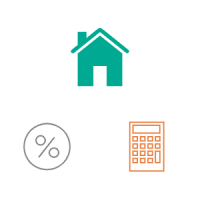
On the other hand, in times of very weak rate of economic growth or in a recession, the majority of people can not afford to buy a new home and are more likely to focus on meeting their daily needs, rather than making such large investments.
Consequently, strong home sales numbers tend to support the currency in question, very often leading to its appreciation. This is why existing and new home sales can be regarded as one of the best Forex indicators, traders can make use of.
To illustrate how the market responds to those announcements, let us take a look at this 5-minute EUR/USD chart:
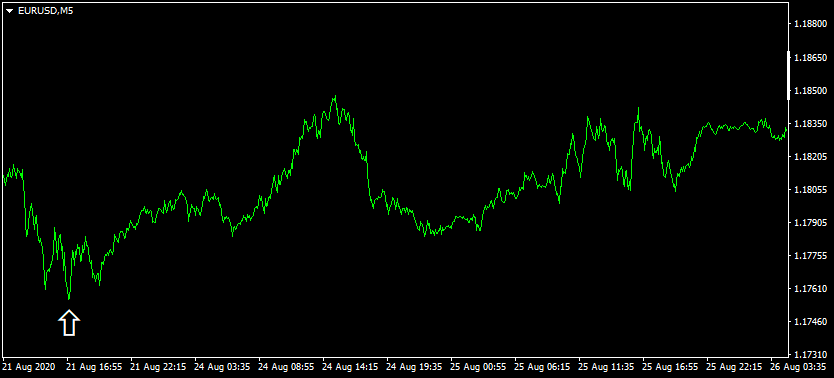
On August 21st, 2020, there was an important economic announcement, according to which, the US existing home sales for July have reached 5.86 million. This was considerably higher than during the previous month when this number stood at 4.70 million. In fact, the actual release has even exceeded the analyst’s expectations, which was at 5.38 million.
As we can see from the chart above, at the time of the news release the EUR/USD pair stood at 1.1755. The initial reaction to this release was an increasing degree of volatility, with the pair eventually stabilizing near the 1.1780-1.1790 range.
Now, this might be surprising to some traders. Logically speaking in light of those positive housing numbers the US dollar should have rallied considerably against the Euro, however, as we can see here the net result of this release was the slight appreciation of the European currency. So how can we explain this?
Well, there are several explanations for this, such as:
- Since late May 2020, the EUR/USD pair is in a solid upward trend, rising from $1.07 all the way up to above 1.17 level. Consequently, the positive housing news from the US might have the effect of slowing down the appreciation of the Euro. However, it was able to reverse the trend.
- An expansion in the housing market is a positive sign for the US economy. However, this news was overshadowed by the 31.7% decline in the gross domestic product (GDP) and the unemployment rate which still remains above 10%. Those numbers suggest that it might take a while before the US economy recovers from this recent downturn.
- According to both the Organization of Economic Cooperation and Development (OECD) and the British Financial journal ‘Economist’, in terms of purchasing power parity (PPP), the Euro is still undervalued against the dollar. Consequently, it is not surprising for this correction to take place and EUR/USD rises as a result.
So as we can see from this example, the housing indicators can be useful for fundamental analysis, however it is very important to take into account other top Indicators for Forex in order to come up with a more accurate analysis.
House Price Index
Another one of the best indicators 2020 traders can use is the house price index. As the name suggests it essentially tracks the latest changes in the prices of single-family homes. Officially it is published as an index, however, with many economic calendars, it is typically expressed as a percentage change over the previous year or month.
It goes without saying that just like with any other market, the home prices are subject to the supply and demand equation. Therefore, if the house prices expand at a considerable pace, this might suggest that there is a strong demand for homes.
In general, housing prices can be quite volatile in the short and medium term. There were times when the home prices were expanding at a rate of 10% per year. On the other hand in times of recession, they fell considerably.
Despite those fluctuations, some studies have shown that on average the housing prices are rising just 1% to 1.5% faster than US CPI. However, here it is worth keeping in mind that some alternative measures of inflation, suggest that the US consumer price index might be understating price rises with the same amount. Consequently, in the long term, it is likely that the housing prices in the long term might be just tracking the inflation rate.
Therefore the house price index might be the best Forex indicator for day trading for every market participant, but it can give them some idea about the latest developments in the housing market.
Now, in order to observe the impact of such news releases on the market, let us take a look at this daily USD/CAD chart:
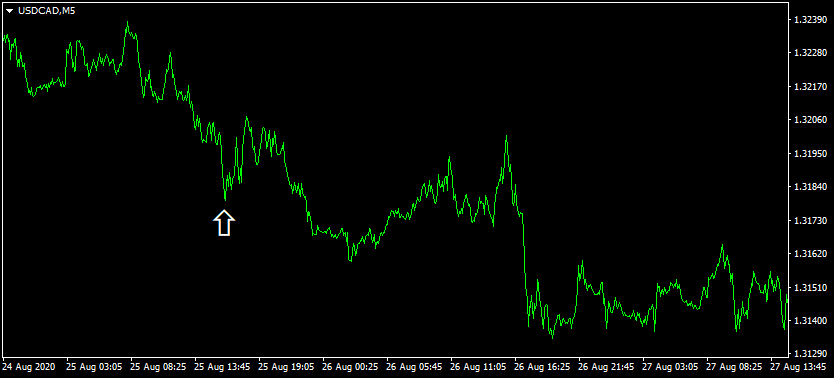
As we can see from the above diagram at the time of the release, the pair was trading at $1.3180. The report has shown that the US home price index has risen by 5.7% in July 2020, compared to July 2019 figures. This was 0.8% higher than during the previous month.
The immediate reaction of the market to this announcement was quite predictable. The US dollar has made some notable gains against the Canadian dollar. As a result, the USD/CAD pair has risen and reached the $1.3208 level.
However, those gains turned out to be short-lived. During the subsequent hours of trading, the Canadian currency has erased its recent losses and by August 27th, the pair was trading all the way down to $1.3140 level.
So as we can see from this example, this news release only had a short term impact on the market. It certainly seems that there were other Forex technical indicators, as well as fundamental factors involved, which led to the decline in the USD/CAD exchange rate.
One of the factors at play here was the fact that the oil price has recovered considerably, since it faced collapse in April 2020. Lately, it is trading within $40 to $45 range. Obviously, it is still lower than at the beginning of the year, however, the recent appreciation of the price of this commodity has indeed given some relief to those Canadian oil companies which struggled with low prices. In addition to that, the Canadian government also benefited from rising tax revenues, due to higher oil prices.
The fact of the matter is that in response to the collapse in oil prices back in April 2020, the Canadian dollar has depreciated rapidly, with the USD/CAD pair going all the way up to $1.45 level. Therefore, it is not surprising that as the price of this commodity recovered, the Canadian dollar started erasing its recent losses.
Rent Index
It might not be a very well-known measure, but the rent index can be one of the top Forex indicators for beginners. As the name suggests, this indicator measures the changes in the rent prices in the country. This is significant in two ways.
Firstly, the rent levels can be one of the measures of overall economic health. The fact of the matter is that in times of recession, there are fewer people who can afford to rent a home. As a consequence, the demand for rental properties dropped considerably.
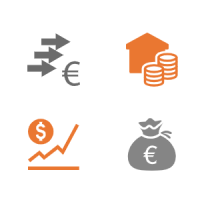
As a result, landlords are forced to reduce their rents in order to keep their properties occupied. It goes without saying that it is better for them to earn at least some amount of income, rather than leave their homes unoccupied for months or even years.
On the other hand, in times of strong economic growth, the demand for rental properties increases notably. This allows landlords to incrementally increase their rents in order to keep pace with inflation. The strength of the economy allows tenants to afford their rents, despite the small price increases.
However, here it is worth noting that this is not the only reason why the rent index might be the best Forex currency indicator for some market participants. The reality of the matter is that in many countries the housing expenses usually make up a significant portion of the consumer price index (CPI). Just to bring one example here, this category makes up more than 40% of the US CPI.
Obviously, the rent is not the only item in the housing category. There are utility payments, furniture expenses, and other items. However, this still does not change the fact that the rent is the largest expense associated with housing.
This means that the latest rent index release can have a significant impact on the CPI of a given country. Therefore, if the rent prices increase notably, it is highly likely that this will push the headline inflation rate considerably higher than before. The opposite is also true. In times of declining rents, very often the CPI also remains broadly subdued as well.
Obviously, there are other Forex indicators for following trends, however, rent index announcements can give traders some valuable insight into the latest inflationary dynamics.
This is important because nowadays nearly every central bank has some sort of target for inflation. The general principle here is that if the CPI rate rises above its intended target to a significant degree, then the central bank might consider raising the interest rates. This in turn makes the currency more attractive, because investors and traders will earn higher returns from savings accounts, certificates of deposits (CDs), as well as from carry trades.
At the same time, if the inflation rate drops much lower than the goal, then it is likely that the policymakers might decide to cut the rates in order to stimulate the economy. Now, this might be a piece of very good news for homeowners, but this also makes the currency in question less attractive for investors and traders.
In order to illustrate this, let us take a look at this daily USD/CHF chart:
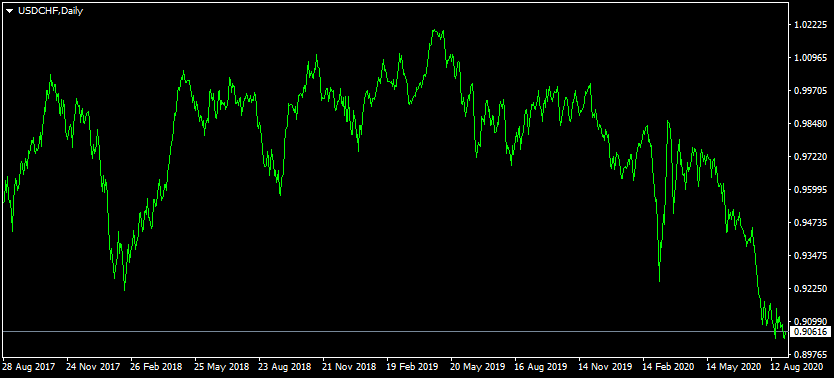
As we can see from this image, during the last 3 years, the pair has gone through 2 distinct stages. Firstly, there was an upward trend for the US dollar. By September 2017, the pair was trading at 0.95 level. After making some steady gains the USD/CHF has reached a peak at 1.02 mark by May 2019.
One of the possible reasons for this was the fact that the US inflation rate was mostly close to 2%, therefore, at that time it seemed unlikely that the US Federal Reserve would have resorted to any drastic easing measures.
On the other hand, since the 2008 Great Recession, the price levels in Switzerland remain flat. The Swiss National Bank has even resorted to setting interest rates at -0.75%, but it did little to change the situation. The fact of the matter remains that the Swiss inflation rate is still near 0%.
Faced with this situation, the traders and investors bought the US dollar and pushed the USD/CHF exchange rate higher. However, this state of affairs did not persist indefinitely. The US inflation rates started dropping, especially after the outbreak of the COVID-19 pandemic.
One of the driving forces behind this was the fact that the rent price rises started to slow down considerably. It is not surprising that this had a negative impact on the CPI as well since it represents one of the largest components.
As a result of those developments, the USD/CHF pair has faced a major reversal, with USD falling steadily over the subsequent months, eventually dropping all the way down to near 0.90 level.
Therefore, as we can see from this example, the latest developments in the rental index can have a notable impact on the consumer price index, which by extension can exercise a significant influence on the currency exchange rates.
Limitations of Housing Indicators
Despite the fact that the housing announcements can be one of the top indicators for Forex trading for some market participants, they do have certain limitations as well. Firstly, it is important to note that the real estate market, just like the stock market, is subject to economic boom and bust cycles. Consequently, it is also susceptible to bubbles as well.
This became very apparent during 2005 to 2008. At the beginning of this period, house prices were rising rapidly. In fact, in some areas, they were expanding at a rate of 10% per year. At the same time, the home sales were rising as well and the rent index was also expanding at a high annual rate.
So in this period if we only used those housing indicators, we might have concluded that the US economy was very strong, would keep expanding at a high pace and consequently, we would have predicted that the USD would strengthen against other major currencies.
Such predictions were made by many commentators and financial experts. However, as we know, those forecasts have turned out to be quite wrong. The fact of the matter was that the US real estate market was in a bubble. Therefore, when this bubble burst, the housing market came crashing down, leading to an extended period of recession.
In addition to that, it is worth noting that 2005 was generally a good year for the US dollar. During this period, the American currency made some notable gains against the Euro and British pound, as well as some other major currencies. However, this is not the case for the next two years. In fact, during 2006 and 2007 USD suffered some heavy losses against its peers, reaching multi-decade lows by Summer 2008.
It was only after the collapse of the US housing market and the beginning of the Great Recession when the US dollar was able to start regaining its footing.
The reality of the matter was the fact that the rising home prices from 2001 to 2007 was not just a result of economic strength. Here it is worth remembering that in response to a recession, the US Federal Reserve took an unprecedented step in lowering the key interest rates to 1%.
It goes without saying that this was a piece of bad news for savers and investors. Since the average long term, the US inflation rate stands at 3%, people are losing their purchasing power if they invest their savings at 1%. Consequently, there was very little incentive for market participants to lose 2% annually to inflation.
Predictably, they turned to other markets in search of higher returns. Some of them have decided to go for a stock market and even purchase some dividend stocks in the process. In many cases, the blue chip dividend-paying stocks can be an effective hedge against inflation.
However, here it is worth remembering that the principal of an invested amount in the stock market is not secure and is very much subject to the day to day market fluctuations. In addition to that, the companies have no obligation to always distribute dividends to its shareholders.
There are indeed some corporations, who have been making payments to their owners for several decades now. However, this does not change the fact that the company boards always have an option to cut dividends or cancel them entirely if the firm faces some financial challenges. This became especially clear during the 2008 Great Recession, as well as in the aftermath of the outbreak of the COVID-19 pandemic.
This is why some investors do not feel very comfortable with the stock market and instead invested in the real estate market. As a result, the housing market became crowded and became a bubble.
However, this appreciation in the home prices was a direct result of very low interest rate policies. So as the Federal Reserve started hiking rates, at some point the house prices collapsed. Therefore, this is just one example of the fact that housing indicators might not always be the most accurate measures of economic performance, available to traders.
Therefore, housing data announcements do not represent the best Forex trend indicators to be used in isolation. Instead, it is important to analyze those in conjunction with other top indicators for Forex trading. This approach can certainly improve the accuracy of currency analysis.
It is also important to point out the fact that the rents are not the only important components in the consumer price index. There are some other categories, which might have a significant impact on the measures. Those include the foods and beverages, medicare, education, transportation, apparel, recreation, and other important items. It is true that in many cases those categories are tied to each other, however, it is important to note that this is not always necessarily the case.
In fact, there can be cases, when the rent index might be flat, or have a small rate of growth, however, the headline inflation rate can be much higher due to rising food prices or increasing transportation costs.
Therefore, if a trader wishes to Forex best indicator for the latest inflationary dynamics, it might be a better idea to take a look not only on housing prices but also to the latest developments with food and fuel prices, as well as some other categories, which make up a significant portion of the consumer price index.
Impact of Housing Market on Forex – Key Takeaways
- There are two types of home sales indicators. One measures the number of newly built homes which have been sold and the other one shows the number of sold existing homes. Both of those are important indicators of the economic strength of the country. This is because, in economically booming times, there are more people to make such a large purchase, compared to in times of economic downturn and a recession.
- The home price index is measured not only in the United States but in the United Kingdom as well. It measures the latest price developments in the housing market. In the short term, home prices might be quite volatile. However, in the long term, they mostly either tend to track the inflation rate, or just rise by approximately 1% higher than the CPI on an annual basis. The declining home prices are generally associated with the economic downturn.
- The rent price index measures the price changes in the rental properties of the single-family homes. This indicator can give traders some valuable information about the latest inflationary dynamics in a given country. The fact of the matter is that in many countries the housing expenses represent a large portion of the consumer price index. Consequently, the latest trends in this market can also impact inflation rates significantly.



